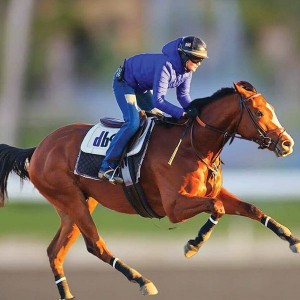 Even in the best of circumstances, there is a tremendous amount of training both on the ground and in the saddle to reeducate a race horse to a trail horse, or any new discipline.
Even in the best of circumstances, there is a tremendous amount of training both on the ground and in the saddle to reeducate a race horse to a trail horse, or any new discipline.
Each year thousands of race horses reach the end of their racing careers, either by injury, not living up to expected potential, or retirement. Many move on to be successfully retrained to excel in new careers, ranging from dressage to hunter-jumpers. However, I need to strongly emphasize that good training takes time, patience and commitment. Thoroughbreds are known for having huge hearts, and once a strong foundation is built and a trust is developed, you will find a partnership like no other.
Lucky is a 6-year-old Thoroughbred gelding that raced and won at Santa Anita and Del Mar race tracks until an injury sidelined him. Rather than choosing euthanasia, the owner was convinced by his trainer to relinquish him to an environment where he could be rehabilitated and retrained. He was delivered to a rescue where he began his long recovery process, and once his injury mended as best it could, a new home was identified and selected. Lucky was brought to me by his new owner to help him make the transition safely from track to trail.
All that I am about to teach Lucky is foreign to him. He has left the only profession he has known, one he was bred for. Everything for him has changed from his boarding environment to his tack. Horses are bred for a variety of traits—some for quiet dispositions, some for a specific conformation that is desirable in specific sport like jumping, and some for instincts like those of a great cow horse. Race horses are bred to run.
I need to redirect Lucky’s instincts, and he needs to trust me to navigate him through unfamiliar territory while out on the trail, going through circumstances he has never been exposed to.
The goal is to ride Lucky safely out on trail, but I don’t start with the goal. Preparation is key. One of the first things I do is desensitize Lucky using a flag. Not because I expect him to be a parade horse, but because it’s the catalyst for teaching trust. The flag simply represents any potential unexpected situation presenting itself while out on the trail that could trigger his flight response. I want him to depend on my direction rather than bolt.
Once in the round pen, I introduce the flag. Lucky immediately reacted and tried to bolt. I had him on a halter and long lead rope, so I was able to stay with him while holding the flag, waving it until he stopped moving his feet. His head was high, and he was by no means relaxed—but he stopped moving his feet. By recognizing the slightest change and releasing the stimuli at that time, you teach what you release. As soon as his feet were still, I dropped the flag and released the pressure the flag presented and let him settle. When he was relaxed, I again picked up the flag. I repeated the lesson until eventually I could pick the flag up, wave it, and he would face me, relax and stop moving.
Next came touching his body with it. This also took repeated attempts, first from a position far away and working up to rubbing his neck, shoulders, barrel and hindquarters. The flag work took some time, a few days. I interspersed the flag work with riding to release any tension built from one repeated exercise. I wanted to set him up for success, so I went back to something he did know, carrying a rider.
While on his back, I continue his training by working him laterally. I need softness in the head, neck, shoulders, rib cage and hind quarters. Unlike racing which is forward-motion only, I need to be able to disconnect his head from his engine (hindquarters) at any time. When his emotions escalate, I get deeper in the saddle and relax so I can be the example he needs to follow. I use one rein and bring his nose to my toe and soften his head and neck and redirect his attention. For the human, this is counter-intuitive and it also goes against your survival instincts. You are aboard a 17.2-hand animal with its own set of thoughts and emotions that is wired for flight. Regardless, you must remain calm, from your jaw, to your shoulders to your legs.
When I am satisfied with his progress in all areas, it’s time for our first trail ride. It will be a short ride and I make sure I am not alone. From there, we continue to build, chipping away at it every day.
–Sheryl
Leave a Comment
All fields must be filled in to leave a message.